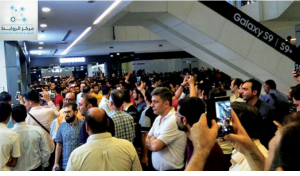On the morning of 24 June, the commercial strike in the Tehran markets occurred and continued for the third day respectively , protests are still in progress and were led by traders protesting against the deteriorating economic situation .The protests took place in the capital Tehran in the field of Bharastan, before the Iranian parliament and the “Bazaar” Tehran market, the electronics market, Laleh Zer and Sartchema commercial streets , and spread to other commercial areas, where the commercial strike extended to commercial areas in south and central Tehran, and the protestors chanted slogans against the regime of the Wilayat al-Faqih, and Khamenei, and the slogans “Neither Gaza nor Lebanon my life is the redemption of Iran” and slogans calling for leaving Syria, including confrontations with the police, and the burning of a police station in front of parliament.
Reasons for protests.
The main reason for the current protests is the collapse of the Iranian currency against the dollar, which fell in less than a month from the fourth t- fifth place to the cheapest currency in the world , 9000 Toman against the dollar, which led to the aggravation of commodity prices and the rise in inflation more than the announced official figure 9.1 %.
The collapse of the exchange rate is linked to the fears of the Iranian regime of the US sanctions coming next August, leading to the scarcity of hard currency, in view of which the regime adopts a proactive austerity policy based on: stop pumping the dollar in the markets, as well as stop cash exchange dealers in the markets .
And the fear of the Iranian citizen of the future in light of the US coming sanctions , pushed him to replace the local currency in dollars or gold. These reasons led to the creation of a crisis in the market and the collapse of the exchange rate.
The future of the protests.
The current protests are different from the previous ones in an important aspect represented by the trade strike for the first time since the Iranian revolution in 1979 and bazaar of Tehran is one of the most important markets that played an influential role during the Iranian revolution. This indicates that the economic sector is being hit by protests against the regime, which is very dangerous to it.
The regime’s awareness of the seriousness of the current protests has prompted it to deal with it with great flexibility, in an attempt to contain it. Despite the anti-regime slogans against Wilayat al-Faqih and Khamene , the police and riot forces have moved away from the escalation, unlike previous demonstrations.
US attempts to pressure Iran, through pressure to cut off communication between Iranian and foreign banks (before the sanctions began in August), have greatly affected the value of hard currency in Iran as a result of its inability to transfer a difficult currency to the inside and major companies started to withdraw from the Iranian market affecting the economy and led to the eruption of the current protests.
The current US sanctions differ from previous sanctions, which did not lead to regime change where former US administrations did not seek regime change and had no problem dealing with political Islam , while the current administration has a different view towards the political Islam in all its categories and doesn’t want to deal with it , and for the first time the US administration imposes real sanctions on the Iranian regime, hitting the backbone of the economy.
The Iranian economy will not be able to withstand much other than previous times, and the crisis will worsen in the coming months with the start of application of sanctions in August, forcing the regime to change its foreign policies and sit at the table with the United States , the regime has no options.
Iranian Studies Unit
Rawabet Center for Research and Strategic Studies

